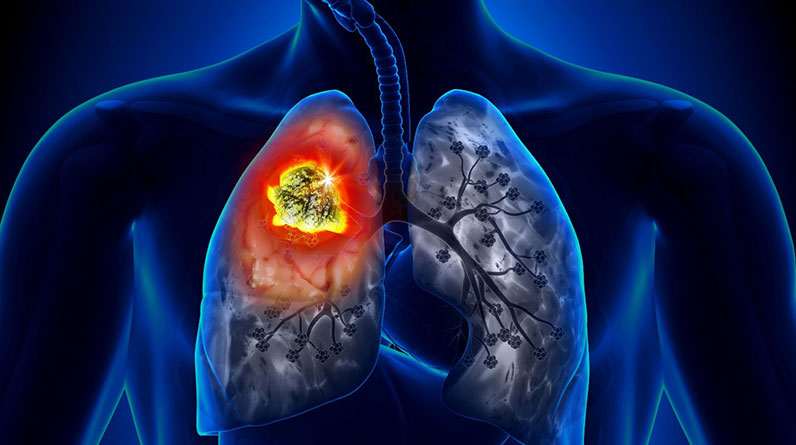
Lung Cancer Risk Factors and Survival Rates
Because men are more likely to smoke, drink, and avoid doctors’ visits, they are more likely to be diagnosed with lung cancer and other health-related conditions. As a result, lung cancer is the leading cause of cancer death amongst men and women alike.
Fortunately, lung cancer is a disease that can mostly be prevented by having a healthy lifestyle. In addition, lung cancer can be treated and cured if diagnosed at an early stage.
What follows will be a discussion of the risk factors and survival rates associated with lung cancer. We’ll also outline the signs and symptoms of lung cancer and discuss effective prevention tactics and treatment protocols.
What is Lung Cancer?
Lung cancer is the overgrowth and spread of abnormal cells within the lung tissue. These abnormal cells begin to grow rapidly and uncontrollably and can spread locally or to locations outside the lungs. While lung cancer can sometimes be removed, there is always the chance that cancer can grow back or recur in this area.
Delay in treatment of any type of lung cancer will lead to further growth and spread and eventual death. Therefore, it’s imperative that lung cancer is diagnosed as early as possible.
Lung cancer spread can be described at three different levels:
- Local: only present in the lungs at the area of origin
- Regionalized: spread to the nearby lymph nodes within the chest
- Distant: spread outside the lungs to other areas of the body
Risk Factors of Lung Cancer
According to the CDC, the number one cause of lung cancer is smoking, associated with nearly 90% of lung cancer diagnoses.
Other common risk factors associated with lung cancer are as follows:
- Genetics and Family History
- Gender (Men Are At Higher Risk)
- Previous Exposure to Radiation
- Previous Exposure to Asbestos
- Previous Exposure to Pollution
- Secondhand Smoke
- Alcohol Abuse
While it’s important to do your best to avoid all risk factors, some are harder to avoid than others. For example, some occupational career workers, such as firefighters, construction workers, and other skilled-trade occupation workers, will likely have environmental exposure to asbestos. Yet, smoking accounts for nearly 90% of cases, thus making it the most crucial risk factor to avoid.
According to the American Lung Association, the lung cancer five-year survival rate is 18.6%, with nearly 50% dying within the first year of diagnosis. The reason for the high death rate associated with lung cancer is likely related to the late detection of lung cancer in general.
Signs and Symptoms of Lung Cancer
Depending on the type of lung cancer and staging, signs and symptoms may be minimal or severe. Sometimes, there will be no symptoms at all. In most cases, however, the symptoms of lung cancer are relatively conspicuous. If these are seen in a male smoker, it’s time for them to seek medical attention right away.
The following are the most common signs and symptoms of lung cancer:
- Shortness of Breath
- Persistent Dry Cough
- Hemoptysis (Coughing Up Blood)
- Extreme Fatigue
- Chest Discomfort During Breathing
- Recurring Infections (Pneumonia, Bronchitis)
- Lumps in Your Neck
- Headache and Dizziness
- Muscular Weakness
- Nausea and Vomiting
- High Blood Pressure Levels
- Unexplained Weight Loss
It’s important to know that all of these symptoms are not exclusive to lung cancer, yet they correlate very highly with the disease. In addition, some of these signs and symptoms may result from the spread of the disease, and individuals can experience pain in other areas, such as the extremities or back.
Preventative Tactics and Treatment Protocols
The prevention tactics pertaining to lung cancer are quite simple. Because the overwhelming majority of cases result from persistent smoking, you can assume that the best course of action is NOT to smoke, and if you do, QUIT immediately.
Other forms of prevention include lifestyle changes (exercise, diet, healthy habits), occupational changes, and environmental changes. Unfortunately, lung cancer risk can’t be avoided in some cases due to personal family history, genetic predisposition, or previous radiation exposure.
Treatment is based on the stage of cancer, which is determined by the type and level of spread. Once the cancer has been staged, treatment recommendations can be made.
The following are the most common treatments for lung cancer:
- Chemotherapy
- Radiation Therapy
- Surgery (Resection, Lobectomy, Pneumonectomy)
- Immediate Lifestyle Changes & Rehabilitation
Since lung cancer is often detected late in men, treating lung cancer can often be more complicated. In certain stages, multiple modalities involving surgery, chemotherapy, and radiation therapy may be suggested. Treatment decisions are usually made using a multidisciplinary team of specialists, including pathologists, oncologists, surgeons, and radiation oncologists. Such an approach helps to make the best possible decisions for the care of the individual with cancer.
Final Thoughts
One key point in the entire discussion is that quitting smoking is one of the best ways to avoid lung cancer. And, if you don’t smoke, certainly don’t start.
As such, it’s essential to take every precaution possible to avoid common risk factors and improve your health and well-being.
Another critical point is to see your doctor or primary care provider on a regular basis. This practice has been proven to be especially important with men who are much less likely to see a doctor at all. If any symptoms are noted, seek immediate medical attention.


